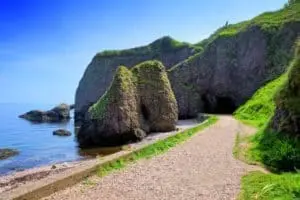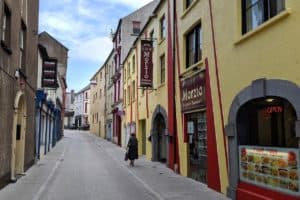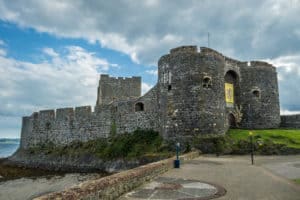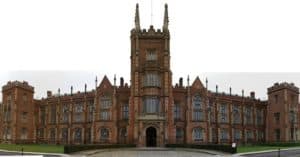From the Emerald Isle to the Caribbean: Unveiling Montserrat’s Irish Heritage

Updated On: April 20, 2024 by Eman Sameh
Montserrat, known as the “Emerald Isle of the Caribbean,” shares more than just a nickname with Ireland; it is deeply rooted in Irish heritage. The island, a British Overseas Territory, became a haven for Irish Catholics in the 17th century. Today, the influence of these Irish settlers can be seen across the island’s culture, from its place names to its annual St. Patrick’s Day celebrations.

Surprisingly to many, Montserrat’s Irish connections are not just historical footnotes but are woven into the fabric of daily life. The island’s geography, demographics, and cultural practices reflect this enduring legacy. Even through political changes, economic challenges, and devastating natural disasters, the spirit of this island’s Irish ancestors remains a vital part of its identity.
History of Irish Settlement in Montserrat
As we explore the significant Irish imprint on Montserrat, it’s essential to consider the early establishment of a society that was unique in the Caribbean due to its Irish Catholic roots and how that legacy has endured.
Colonisation and Ownership
In the 17th century, Montserrat became a destination for Irish Catholics seeking new lives. Sir Thomas Warner facilitated the settlement of Irish Catholics on the island, having previously colonised neighbouring St Kitts. The island was transformed into an English colony in 1632, allowing these Irish exiles a chance to establish a community under Britain’s growing colonial reach.
Indentured Servants and Slavery
Many Irish people arrived in Montserrat not by choice but as indentured servants. Under Cromwell’s rule, thousands were sent to the Caribbean, Montserrat included. The island’s plantations relied on this servitude, which, over time, included the forced labour of African slaves. The merging of Irish indentured labour and African slavery created a complex society.
Cultural Fusion and Resistance
The society that formed on this island from these origins was marked by cultural fusion. Irish Catholics, African slaves, and plantation owners all contributed to the melting pot. Tensions existed, with accounts of resistance and uprising, as individuals sought freedom from oppressive systems. This strife and the eventual end of slavery in the 19th century would redefine the island’s social landscape.
Montserrat Today: Geography and Demographics

Montserrat is a Caribbean Island that boasts a rich blend of geographical features and a population with a storied heritage, prominently of African ancestry and Irish descent. Our exploration reveals a land shaped by its volcanic activity and a culture that is a testament to its diverse population.
Geographical Features
Montserrat, known for its Soufrière Hills volcano, offers a dramatic landscape that includes lush Centre Hills and deep ghauts—ravines that funnel rainwater to the sea. The Exclusion Zone in the south remains off-limits due to volcanic activity, where the former capital, Plymouth, lies buried. The northern part of the island features fertile land and pristine coral reefs bordering its coastlines.
Population and Ethnic Composition
Montserratians reflect a tapestry of ethnic backgrounds; most possess African ancestry intertwined with ties to Irish descent. The island’s population is concentrated in the safe zone in the north, as much of the island was rendered uninhabitable by the 1995 volcanic eruption. Our community is small and resilient and proudly maintains cultural ties to both African and Irish traditions.
Cultural Heritage: Irish Influence on Montserrat
Montserrat embodies a vibrant tapestry of culture where the profound influence of the Irish heritage is woven into its social fabric. From distinctive celebrations to iconic symbols, the island’s customs evoke a strong sense of connection to Ireland.
Festivals and Holidays
Among Montserrat’s most notable cultural imports is the festive St Patrick’s Day, a public holiday that fuses Irish and Caribbean traditions. Uniquely, this event also commemorates an 18th-century slave uprising, making it a poignant date in the Montserratian calendar. The island’s St Patrick’s Day festivities stand out for their ten-day duration, attracting visitors with a blend of traditional Irish music, African and Irish dance, and historical re-enactments.
Dress and Symbols
Montserrat’s national dress prominently features the Irish Tartan, hinting at the deep-rooted ties to Irish identity. Adornments such as shamrocks symbolise this connection further, as this Irish emblem appears across the island, from government insignia to architecture. Meanwhile, national celebrations may witness a nod to the whimsical, with the figure of leprechauns being playfully incorporated into the local lore and festivities, embodying the spirit of shared heritage and joy.
Political and Social Dynamics

As we explore Montserrat’s political and social dynamics, we must understand its intricate past shaped by colonial rule and the spirited movements for freedom that have defined the island’s identity.
Colonial History and Governance
Montserrat, often referred to as the “Emerald Isle of the Caribbean” due to its Irish heritage, was colonised by the British in the 17th century. This period profoundly influenced our governance structure, including the institution of a British Governor to administer the island’s affairs. The Island has been an Overseas Territory of the United Kingdom since Elizabeth II’s era, reflecting a colonial legacy that continues to shape our political framework.
Movements for Freedom
Movements for freedom have been a significant part of the island’s narrative. We remember figures like Cudjoe, a symbol of strength, who led the rebellion against the persecution of enslaved peoples in the Caribbean. Such movements have been instrumental in Montserrat’s social transformation, highlighting the relentless pursuit of our people for self-determination and rights.
Economic Life: Past and Present

As we explore Montserrat’s economic transformation, it is imperative to understand how historical industries have paved the way for current economic pursuits. From the cultivation of valuable crops to an emphasis on tourism, Montserrat’s economy reflects both its rich heritage and adaptive modernity.
Agriculture and Plantations
Historically, Montserrat’s economy was heavily reliant on agriculture and plantations. The fertile volcanic soil supported cultivating valuable cash crops such as cotton, tobacco, and indigo. These commodities were central to the island’s economic life during the 17th and 18th centuries, driven by the labour of enslaved Africans and indentured Irish servants. Our neighbour, Antigua, also played a significant role in this plantation economy, often sharing similar agricultural profiles and challenges.
Modern Economy and Tourism
In contrast, today’s Montserratian economy has diversified. Following the devastating impact of volcanic eruptions in the 1990s, we’ve witnessed a significant shift towards tourism. Tourists are drawn to our unique Irish heritage, stunning landscapes, and the dramatic spectacle of an island still emerging from the shadow of natural disaster. While traditional agriculture endures on a smaller scale, it is the allure of our history and the warmth of our people that transforms the economic landscape, inviting visitors from the Virgin Islands to the wider Caribbean region. Our approach to tourism is calibrated to appreciate and preserve Montserrat’s enchanting environment, leaving a light footprint even as we welcome the world to our Emerald Isle of the Caribbean.
Natural Disasters and Resilience

As an island with a history deeply intertwined with Irish and African heritage, Montserrat has shown remarkable resilience in the face of recurrent natural disasters, most notably volcanic eruptions and hurricanes, which have shaped its landscape and people.
Volcanic Activities
Montserrat’s resilience is exemplified by its response to the Soufrière Hills Volcano. This volcano, dormant since the late 1970s, reawakened in 1995, leading to extensive damage and creating an exclusion zone covering over half the island. The eruptions resulted in the abandonment of the capital, Plymouth, and posed significant challenges for the inhabitants of Montserrat.
Hurricanes and Recovery Efforts
Montserrat’s resilience is further tested by tropical cyclones. In 1989, Hurricane Hugo struck the island, leaving a trail of devastation in its wake, with over 90% of the structures on the island damaged or destroyed. Recovery efforts post-Hurricane Hugo were substantial, laying the groundwork for how the island prepares for and recovers from such calamitous events. The local populace and governing bodies have since improved infrastructure and emergency response strategies to better withstand future hurricanes.
Arts and Music

In Montserrat, the fusion of Irish heritage and Caribbean influence forms a vibrant tapestry in both arts and music, reflecting a cultural identity unique to this ‘Emerald Isle’ of the Caribbean.
Music Genres and Influences
Montserrat’s musical landscape is an eclectic blend steeped in history. The island’s music has been shaped by Irish traditions, manifesting in the set dance-like Bam-chick-lay and upheld by instrumental ensembles reminiscent of the Irish bodhrán. Meanwhile, the island’s African roots are evident in the rhythmic jumbie dance, with its vibrant tradition persisting in using instruments like the shak-shak, originally made from a calabash gourd.
Famous Personalities
One cannot discuss Montserrat’s musical heritage without mentioning Sir George Martin, the iconic music producer known for his work with The Beatles. He founded the world-renowned AIR Studios Montserrat, attracting a plethora of famous personalities in the music industry. While natural disasters have since claimed the studio, Sir George Martin’s influence on the island’s music scene is indelible. He intertwined the legacy of the Caribbean and Ireland in a symphony of cultural collaboration.
Cuisine and Traditional Foods
Montserrat, known as the ‘Emerald Isle of the Caribbean,’ boasts a unique culinary tapestry woven from its Irish heritage and the bountiful influences of African and Caribbean gastronomies. Our table celebrates this blend, showcasing local staples and island flavours.
Local Delicacies
Goat Water is the national dish of Montserrat, a hearty and nourishing stew that has deep roots in our island’s culinary traditions. This robust concoction, often spiced with clove and rum, marries the local goat meat with fresh vegetables, highlighting the fusion of Irish and African influences on our palate.
The island’s fertile volcanic soil also provides us with an abundance of fruits, including mangoes, bananas, and coconuts. These fruits play a pivotal role in our cuisine, whether in sweet concoctions or savoury delights. These fruits not only provide vital nutrients but are also integral to the unique flavour profiles in our dishes.
International Influences
The waves that brought the Irish to the shores of Montserrat also ushered in culinary influences from other lands. The Irish influence is particularly noticeable in St. Patrick’s Day celebrations when traditional Irish dishes are served alongside our local fare.
Moreover, the Caribbean region, a melting pot of cultures, has seasoned our cuisine with various spices and cooking techniques. African ingredients and traditions have significantly impacted our culinary practices, introducing dishes like saltfish and ackee, which have become staples in our diet alongside the treasured recipes passed down from our Irish ancestors.
Flora and Fauna of Montserrat

Montserrat’s landscape is a haven for diverse species, including some unique to the island. Here, nature thrives, with both its flora and fauna contributing to a delicate and vibrant ecosystem.
Endemic Species
Our island is a sanctuary for various endemic species that have adapted to the specific environmental conditions here. Notably, the Mountain Chicken (Leptodactylus fallax), which is not a bird but one of the world’s largest frogs, is native to the island. However, its numbers have declined due to disease and environmental changes. Additionally, the Galliwasp is a lizard that slinks through the underbrush, a lesser-seen but integral part of our ecosystem.
Conservation Efforts
We are steadily working on conservation efforts to protect these unique species. Turtles nest along our shores, and safeguarding their nesting sites has become a priority. Our concerted efforts also extend to the various birds that grace the Montserrat skies. Through strict monitoring and protection programs, we aim to shield these creatures from the pressing threats of habitat loss and human interference.
Migration and the Diaspora
The Irish influence on Montserrat has been profound, stemming from waves of migration that have left a lasting impact on the island’s demography and culture. Montserrat, often fondly referred to as the “Emerald Isle of the Caribbean,” bears witness to this unique historical connection.
Historic Migrations
The Irish diaspora found its way to the Caribbean as early as the 17th century, when the first significant wave of Irish emigrants, primarily from Dublin and Belfast, settled in Montserrat. This movement was partly involuntary, as many Irish were sent to the island as indentured servants. Throughout the years, the interwoven fate of the Irish and African slaves transformed Montserrat’s ethnic composition. Today, archaeological work and historical research continue to shine a light on these migratory patterns and their effects.
Contemporary Montserratian Communities Abroad
In modern times, the descendants of Montserrat have established significant communities, particularly in Canada, the United States, and notably in Virginia, where many have sought new opportunities. Despite their dispersal, these communities maintain robust ties with their ancestral homeland, nurturing their cultural heritage by commemorating Montserratian traditions and history. Through various events and networks, they contribute to a vibrant global Montserratian identity.
Tourism on the Emerald Isle of the Caribbean

As we explore Montserrat, known as the Emerald Isle of the Caribbean, we find a unique blend of Irish heritage and Caribbean charm. This section will guide you through the island’s top tourist draws and the comfortable stays that await visitors.
Main Attractions and Activities
Little Bay, the heart of Montserrat’s developing port area, is the island’s focal point for future tourism. With its delightful beach and burgeoning facilities, it remains a popular spot for both locals and travellers. Further, the island entertains its guests with a wealth of activities rooted in natural and cultural beauty. For instance, one can explore the Montserrat Volcano Observatory to understand the history and impact of volcanic activity on the island.
The island vigorously celebrates its Irish heritage, especially on St. Patrick’s Day, making it an ideal time to enjoy the festivities. A hike to the Petroglyphs reveals rock carvings left by the island’s ancient inhabitants, providing a glimpse into a long-gone era. Meanwhile, the annual St. Patrick’s Day festival infuses Caribbean enthusiasm into Irish traditions, complete with colourful parades and cultural events.
Moreover, the island’s natural landscapes offer ample opportunities for hiking, bird watching, and diving in pristine waters. At the end of a sunny day, you might sample some local Guinness or indulge in local culinary delights that reflect the island’s mixed heritage.
Accommodation and Hospitality
Montserrat’s cosy accommodation scene adds a personal touch to the visiting experience. Among the charming choices is Gingerbread Hill, a delightful retreat that reflects the island’s tropical environment. Here, visitors can stay in accommodations that offer splendid views and authentic island living.
For a more luxurious stay, Tropical Mansion Suites presents elegant rooms with modern amenities, ensuring comfort amidst tropical beauty. Olveston House is another excellent choice for visitors looking for a quaint and intimate setting with a hint of historical charm.
For those preferring to immerse themselves in the tranquil island life, selecting one of the available Villas could offer the serenity and privacy desired. These residences provide a true home away from home and are perfect for longer stays or for those who crave a retreat into tranquillity after a day of exploration.
Throughout the island, Montserrat’s warm hospitality is unmistakable, and stays are designed to make guests feel part of the community. With a confident step, we invite you to experience the allure and warmth of tourism on the Emerald Isle of the Caribbean.
Frequently Asked Questions

In this section, we explore the intricate tapestry of Montserrat’s Irish heritage, touching on historical migrations and cultural influences that connect the ‘Emerald Isle of the Caribbean’ with its Irish roots.
What historical events led to the migration of the Irish to Montserrat?
The migration of the Irish to this island in the 17th century was largely prompted by the forced transportation of Irish political prisoners, indentured servants, and prisoners of war. The Cromwellian conquest of Ireland saw many Irish sent to the Caribbean islands as labourers.
Which surnames in Montserrat can be traced back to Irish lineage?
Many surnames in Montserrat such as Riley, Daley, and Sweeney reflect an Irish lineage. These surnames are a direct legacy of the Irish who settled on the island during the 17th century.
How has Irish heritage influenced the culture of Montserrat?
Irish heritage is deeply woven into the cultural fabric of Montserrat, reflected in folk songs, dance styles, and even dialects. Montserrat is known for celebrating St. Patrick’s Day as a national holiday, a homage to its Irish roots.
What is the nature of the Irish and Caribbean connection in Montserrat’s history?
The Irish and Caribbean connection in Montserrat’s history is complex and multifaceted, involving not just migration but also the transatlantic slave trade. Irish indentured servants and African slaves shared a common bond in their subjugation, leading to cultural exchanges and intermarriage.
How do the accents of Montserrat reflect its Irish roots?
The accent of Montserratians evokes their Irish ancestry, showcasing a lilting quality that is reminiscent of the Irish brogue. This unique Caribbean patois is a result of the blending of African linguistic patterns with the Irish vernacular.
In what ways did the history of Ireland intersect with the Caribbean slave trade?
Ireland’s history intersected with the Caribbean slave trade in the 17th and 18th centuries, with many Irish involved either as forced labourers alongside African slaves or as part of the administrative apparatus that sustained the slave-driven plantation economy.






